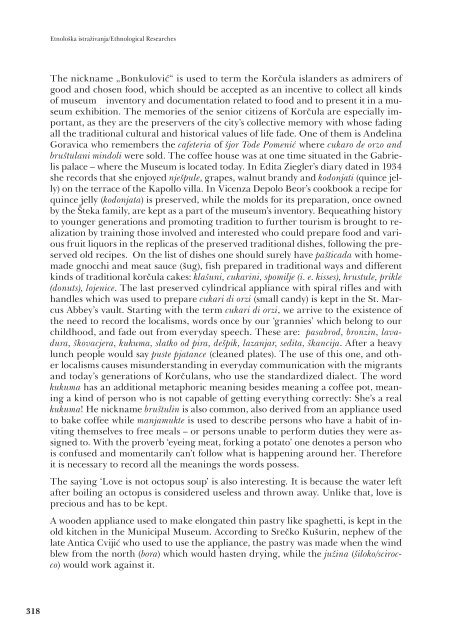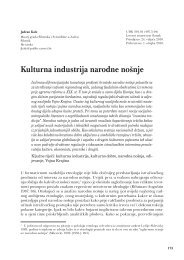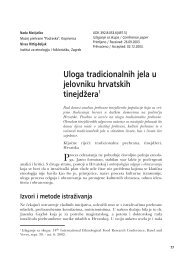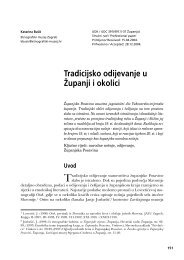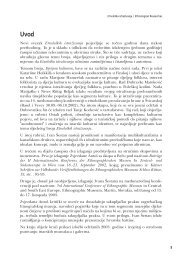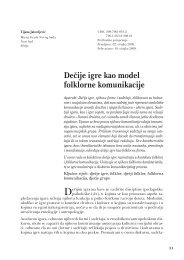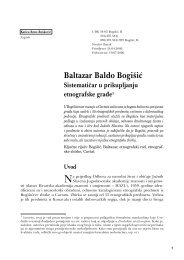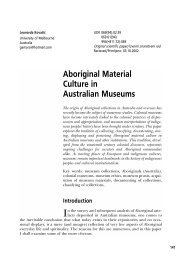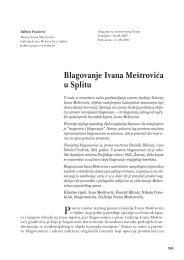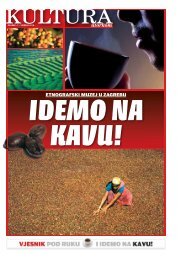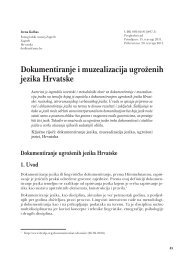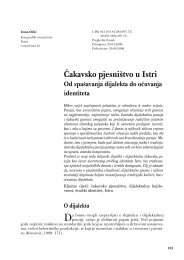U kuhinji i za stolom korÄulanske graÄanske obitelji â poticaj ... - EMZ
U kuhinji i za stolom korÄulanske graÄanske obitelji â poticaj ... - EMZ
U kuhinji i za stolom korÄulanske graÄanske obitelji â poticaj ... - EMZ
Create successful ePaper yourself
Turn your PDF publications into a flip-book with our unique Google optimized e-Paper software.
Etnološka istraživanja/Ethnological Researches<br />
The nickname „Bonkulović“ is used to term the Korčula islanders as admirers of<br />
good and chosen food, which should be accepted as an incentive to collect all kinds<br />
of museum inventory and documentation related to food and to present it in a museum<br />
exhibition. The memories of the senior citizens of Korčula are especially important,<br />
as they are the preservers of the city’s collective memory with whose fading<br />
all the traditional cultural and historical values of life fade. One of them is Anđelina<br />
Goravica who remembers the cafeteria of šjor Tode Pomenić where cukaro de orzo and<br />
bruštulani mindoli were sold. The coffee house was at one time situated in the Gabrielis<br />
palace – where the Museum is located today. In Edita Ziegler’s diary dated in 1934<br />
she records that she enjoyed nješpule, grapes, walnut brandy and kodonjati (quince jelly)<br />
on the terrace of the Kapollo villa. In Vicen<strong>za</strong> Depolo Beor’s cookbook a recipe for<br />
quince jelly (kodonjata) is preserved, while the molds for its preparation, once owned<br />
by the Šteka family, are kept as a part of the museum’s inventory. Bequeathing history<br />
to younger generations and promoting tradition to further tourism is brought to reali<strong>za</strong>tion<br />
by training those involved and interested who could prepare food and various<br />
fruit liquors in the replicas of the preserved traditional dishes, following the preserved<br />
old recipes. On the list of dishes one should surely have pašticada with homemade<br />
gnocchi and meat sauce (šug), fish prepared in traditional ways and different<br />
kinds of traditional korčula cakes: klašuni, cukarini, spomilje (i. e. kisses), hrustule, prikle<br />
(donuts), lojenice. The last preserved cylindrical appliance with spiral rifles and with<br />
handles which was used to prepare cukari di orzi (small candy) is kept in the St. Marcus<br />
Abbey’s vault. Starting with the term cukari di orzi, we arrive to the existence of<br />
the need to record the localisms, words once by our ‘grannies’ which belong to our<br />
childhood, and fade out from everyday speech. These are: pasabrod, bronzin, lavadura,<br />
škovacjera, kukuma, slatko od pira, dešpik, la<strong>za</strong>njar, sedita, škancija. After a heavy<br />
lunch people would say puste pjatance (cleaned plates). The use of this one, and other<br />
localisms causes misunderstanding in everyday communication with the migrants<br />
and today’s generations of Korčulans, who use the standardized dialect. The word<br />
kukuma has an additional metaphoric meaning besides meaning a coffee pot, meaning<br />
a kind of person who is not capable of getting everything correctly: She’s a real<br />
kukuma! He nickname bruštulin is also common, also derived from an appliance used<br />
to bake coffee while manjamukte is used to describe persons who have a habit of inviting<br />
themselves to free meals – or persons unable to perform duties they were assigned<br />
to. With the proverb ‘eyeing meat, forking a potato’ one denotes a person who<br />
is confused and momentarily can’t follow what is happening around her. Therefore<br />
it is necessary to record all the meanings the words possess.<br />
The saying ‘Love is not octopus soup’ is also interesting. It is because the water left<br />
after boiling an octopus is considered useless and thrown away. Unlike that, love is<br />
precious and has to be kept.<br />
A wooden appliance used to make elongated thin pastry like spaghetti, is kept in the<br />
old kitchen in the Municipal Museum. According to Srečko Kušurin, nephew of the<br />
late Antica Cvijić who used to use the appliance, the pastry was made when the wind<br />
blew from the north (bora) which would hasten drying, while the južina (šiloko/scirocco)<br />
would work against it.<br />
318


